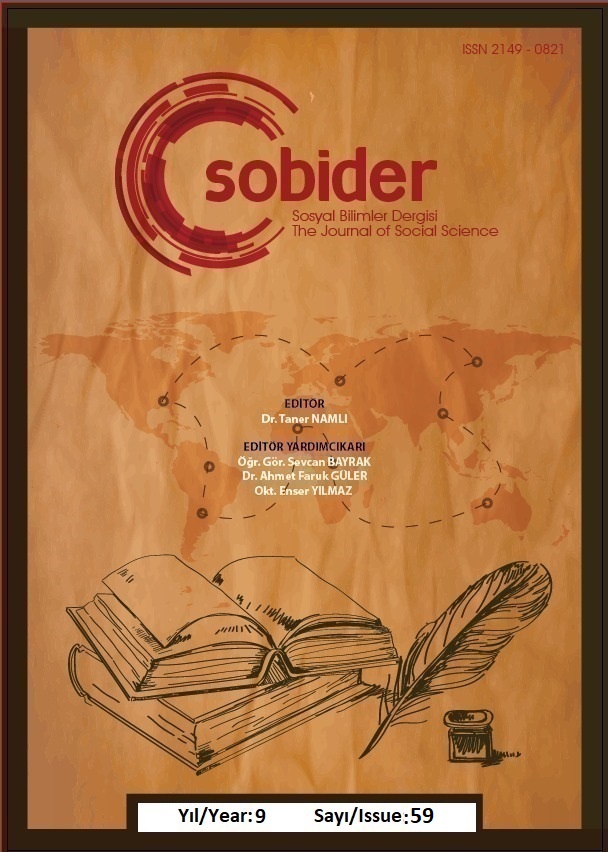Author :
Abstract
Her sanatçı ürettiği eserinde kişiliğinin ve yaratıcılığının derinliklerinde bulunan birçok imgeyi kullanabilmektedir. Sanatçının bilerek ya da hayal gücünün verdiği yetkinlikle bilinçaltına gönderdiği biçimleri ortaya çıkarma isteği ve bu imgeleri kullanmaya ihtiyaç duymasının birtakım sebepleri olabilmektedir. Sık sık kullanılan bu biçemler sanatçıların odak noktasını tespit etmede bizlere olanak tanımaktadır. Egon Schiele’nin eserlerinde en çok kullandığı imgenin kendisi olduğunu, yapmış olduğu yüzü aşkın otoportreden anlamaktayız. Sansasyonel sanat yaşamı ve eserleriyle eleştirmenlerin odak noktası olan Schiele portreleriyle her zaman tanınmıştır. Ancak sanatçının antropomorfist anlayışta betimlediği manzaraları, kent ve kasaba resimleri onu hem simgeci anlayıştan hem de ekspresyonist düşünceden ayırmıştır. Schiele’nin manzara resimlerinde öykünmeci bir kurguyu ya da doğanın kopyasını sunan bir düzenlemeyi göremeyiz. Sanatçı doğaya, evlere, sokaklara insansı nitelikler katarak ve yeniden yorumlayarak izleyiciye sunar. Bu çalışmanın amacı Schiele’nin antropomorfist manzara resimlerini biçimsel sanat eleştirisi yöntemiyle incelemek ve sanatçının portrelerinde benimsediği sanat üslubunu, manzara resimlerinde de farklı bir boyuta taşıyarak izleyiciye sunduğunu göstermektir.
Keywords
Abstract
Each artist can use many images hidden in the depths of his inner world, personality and creativity in his / her works. The artist's desire to reveal the forms that are sent to the subconscious with the competence provided by imagination or intentional action and the need to use these images may be associated with some reasons. These frequently used styles allow us to determine the focal point of the artists. It is obvious from over hundred autoportraits that the most frequently used image by Egon Schiele in his works is solely himself. Schiele, who is the major focus of critics with his sensational artistic life and works, has always been renowned for his portraits. However, the landscapes painted by the artist, the paintings of the city and the towns in anthropomorphist style, distinguishes him from both symbolism and expressionism. In Schiele's landscape paintings, we cannot see an arrangement that offers a mimetic fiction or a copy of nature. The artist presents it to the audience by adding humanist qualities to nature, houses and streets and reinterpreting them. This study is aimed to examine the anthropomorphist landscape paintings of Schiele by stylistic art criticism and to show that the artistic style adopted by the artist in his portraits to the audience by transferring the artistic style to a different dimension in the landscape paintings.
Keywords
- Erarslan, L. (2011). Sosyolojik Metaforlar. Akademik Bakış Dergisi, 1-22.
- Escalera, C. C. (2008). Egon Schıele: el médıco fılósofo que se convırtıó en sacerdote del cuerpo. Fedro, Revista de Estética y Teoría de las Artes(7), 59-84.
- Keser, N. (2005). Sanat Sözlüğü. Ankara: Ütopya.
- Külekçi, N. (2011). Edebi sanatlar. Ankara: Kültür Bakanlığı Yayınları.
- Nebehay, C. M. (1979). Egon Schiele 1890-1918 Leben. Briefe. Gedichte . Salzburg: Salzburg u. Wien.
- Nikolaevna, G. A. (2017, Temmuz 30). esthetızatıon of mental pathologıes as an artıstıc phenomenon (by the example of the creatıvıty of Egon Schıele and Hans Bellmer). Rusya.
- Resnik, S. (2000). The hands of Egon Schiele. Int Forum Psychoanal, 113-123.
- Ryantová, Z. (2016). Egon Schıele: autoportréty z let 1910 a 1911 v kontextu psychopatologıe. Acta Univarsitatis Carolinae PAG. 249–263, 249-263.
- Smith, K. E. (2000, June). Egon Schiele treescapes.work and world: unframing the autonomous landcapes. Art History, 23(2), 233-261.
- Sözen, M., & Tanyeli, U. (1994). Sanat kavram ve terimleri sözlüğü. İstanbul: Remzi Kitabevi.
- Steiner, R. (1993). Egon Schiele 1890-1918 ressamın karanlık ruhu. (A. Antmen, Çev.) İstanbul: ABC Kitabevi.
- Vittori, G. (2018). Choreographing expressionist paintings: claudia contin arlecchino dances Egon Schiele. Dans Chronicle, 41(2), 212-238. doi:https://www.tandfonline.com/action/showCitFormats?doi=10.1080/01472526.20
- Şekil 2: https://byronsmuse.wordpress.com/2021/03/03/egon-schiele-sunflowers-1909/





